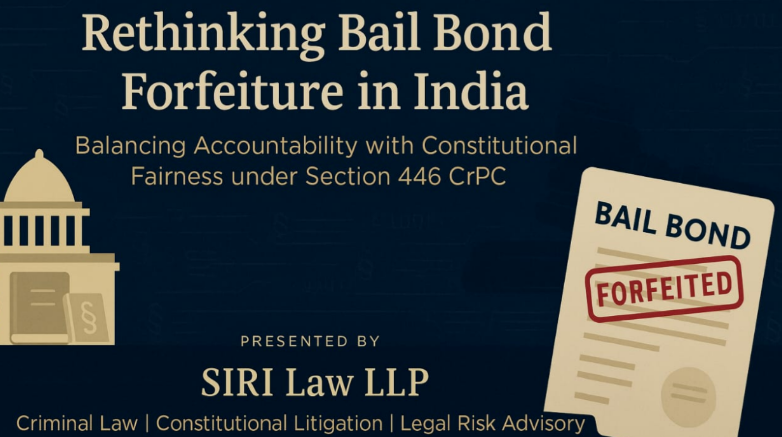
In India’s evolving legal landscape, the enforcement of bail bond forfeiture has come under increased scrutiny. While originally intended to uphold the integrity of criminal proceedings, this mechanism has often been applied in a manner that raises serious questions about procedural fairness, judicial discretion, and the constitutional balance between liberty and order.
This article explores the mechanics of bail bond forfeiture, assesses key judicial interpretations, and proposes a recalibrated approach that aligns enforcement with the constitutional mandate of justice.
The Legal Foundation of Bail Bond Forfeiture
Bail bonds serve as legal instruments that secure an accused person’s appearance in court, generally through a financial or personal guarantee. When the accused fails to appear, the court is empowered under Section 446 of the Code of Criminal Procedure, 1973 (CrPC) to initiate forfeiture proceedings.
While the law provides a framework, its implementation has often been inconsistent, with lower courts exercising wide discretion and accused persons and sureties frequently caught in procedural ambiguities.
Judicial Evolution and the Shift Toward Proportionality
Over the years, the higher judiciary in India has refined the principles governing bond forfeiture. Courts have reiterated that non-appearance alone should not automatically trigger penalties. Factors such as the intent of the accused, bona fide reasons for absence, and the financial status of sureties must be taken into account.
Judgments from 2015 onwards have reflected this evolving approach, wherein courts have begun requiring detailed justifications before confirming forfeiture orders. This jurisprudential shift affirms that enforcement must not override the individual’s right to a fair hearing.
The Risk of Mechanical Enforcement
Despite judicial caution, ground-level enforcement often remains mechanical. This is particularly concerning in rural and economically disadvantaged regions, where sureties may not fully comprehend the legal obligations they are undertaking. In such contexts, bond forfeiture without procedural safeguards risks turning a protective legal mechanism into a punitive trap.
Moreover, inconsistent practices across jurisdictions point to the absence of unified guidelines on how forfeiture is to be applied, reviewed, or mitigated in light of subsequent appearances or remedial actions.
International Comparisons and Reform Imperatives
Comparative legal systems offer valuable insight. In jurisdictions like the United Kingdom and several states in the United States, bail reform has focused on risk-based assessments rather than monetary bonds. These systems prioritize community ties, likelihood of appearance, and the nature of the offence in determining pretrial release conditions.
India can benefit from adopting elements of these models, including:
- Codified review processes for forfeiture orders.
- Training modules for judicial officers on equitable application of Section 446.
- Digital systems for notification and appearance tracking.
Recommendations for a Balanced Regime
To restore public faith and ensure constitutional compliance, India’s criminal justice system must reconfigure the current approach to bail bond forfeiture. The following measures are imperative:
- Codification of Guidelines Introduce uniform protocols under the CrPC or judicial guidelines to standardize forfeiture assessments.
- Technological Integration Deploy digital reminders, mobile-based attendance verification, and biometric ID linking to minimize non-appearances.
- Support Infrastructure for Sureties Establish surety education and legal aid cells at the district court level to promote awareness and accountability.
- Stronger Appellate Oversight Encourage High Courts to monitor district-level forfeiture trends and set performance indicators for judicial prudence.
- Policy Dialogue and Legislative Action Engage with stakeholders from the bar, bench, and civil society to initiate structured reforms to Section 446 CrPC and its application.
Conclusion
Forfeiture of bail bonds must operate as a tool of accountability-not retribution. The current system, if left uncorrected, risks undermining the very liberties the legal system is designed to protect. A just legal order requires that sanctions be rational, proportionate, and above all, fair.
As India continues to modernize its criminal procedure, bail bond enforcement should reflect both the principles of rule of law and the constitutional promise of justice. Reforming this mechanism is not merely about easing procedural burdens; it is about reaffirming the ethical foundation of legal process.
About SIRI Law LLP
SIRI Law LLP is a forward-thinking legal institution committed to delivering clarity, trust, and strategic excellence across key areas of Indian law. Our team advises and represents clients in corporate and commercial law, criminal litigation, white-collar defence, regulatory compliance, financial services law, real estate disputes, and intellectual property rights. We also offer specialised services in public policy advisory, due diligence, and pre-litigation risk assessments-particularly for clients impacted by procedural complexities such as bail bond forfeiture.
In matters involving criminal law, we assist corporates, financial institutions, non-profit organizations, and high-net-worth individuals in navigating the intricacies of legal compliance, including representation during bond recovery actions, surety litigation, and policy guidance. We combine legal precision with contextual insight to safeguard client interests in all forums of adjudication.
We are committed to shaping a legal culture where constitutional integrity meets practical action. To learn more or to partner with our team, visit www.sirilawllp.com or follow us on LinkedIn.
